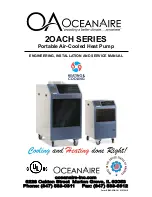
Waukesha Cherry-Burrell
Maintenance
11/2012
95-03057
Page 43
inspected for flaking of the chrome. Normally, tubes will develop
phonographic patterns from blade contact and rotation; this
phonographic pattern is generally visible to the eye but is not
significant unless detectable by touch. Scoring is significant when
the base metal has been damaged; roughness of the tube wall is
obvious both visually and by touch. A badly scored tube will make
cleaning more difficult, reduce heat transfer, result in poor
performance and increase blade wear.
Re-conditioning the tube is the only way to restore performance.
If there is suspicion that scoring has penetrated the tube wall, the
unit can be pressure tested by turning on the jacket media and
observing the inside of the tube for leaks.
Tubes should be removed every 12 to 18 months for cleaning
debris from the media side. Jacket side O-rings should be
replaced when tubes are reinstalled.
Care of Heat Exchanger
Tube
You probably recognize that your Votator
®
and Thermutator
®
Heat Exchangers are valuable elements of your production
facility. Day in and day out, they continuously and efficiently heat
and cool products that often cannot be handled in any other
equipment. You may not be aware that these units are
considered pressure vessels under the ASME Code, and that
SPX is the only facility authorized to make OEM repairs to the
removable tubes that maintain their ASME Code certification.
This certification is your assurance that the equipment meets its
original design pressure rating.
NOTE:
Repair work must be performed
by a shop with ASME certified welders.
The heat exchanger tubes are ASME
coded parts. Failure to get repairs done
by an ASME coded machine shop with
certified welders will void the warranty
and possibly void insurance. SPX has all
required certifications necessary for
repair of ASME coded parts.
The removable tubes are wear parts, and must be replaced when
they lose too much metal. Their inner surface is scraped by
rotating blades and is potentially exposed to corrosive or abrasive
products or cleaners. In some cases chrome plating is applied to
resist mechanical wear, but it eventually wears away or the tubes
become damaged or scored and lose performance. SPX can
inspect the tubes against the original drawings and determine
whether they can be honed to restore a smooth inner surface,
while keeping enough tube wall thickness to satisfy the ASME
Code design calculations. Removable tubes that are worn
beyond repair are condemned by our facility for your protection.
A breach in the removable tube that occurs during operation
could be an extremely costly and hazardous event. In a recent
incident, a removable tube was honed by an unauthorized
machine shop that removed too much metal. The extremely thin
tube wall flexed under the pressure of the product and the
scraping blade edge, until one blade penetrated and tore a hole
in the tube. Consequences of this kind of failure can include:
contamination of product - with a damaging recall; circulation of
product throughout a media system like a refrigeration
compressor installation; and/or release of a hazardous substance
like ammonia refrigerant inside your facility! Even if these are not
high risks in your application, your production line will be down or
operating at reduced capacity for some time until a replacement
tube can be obtained.
Having your tubes professionally repaired by SPX just makes
sense, but there are other potential benefits as well. Maintaining
ASME certification keeps you in compliance with state and local
















































